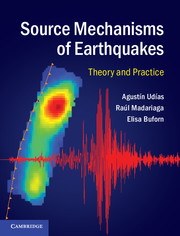Book contents
- Frontmatter
- Contents
- Preface
- Chapter 1 Earthquakes and fault motion
- Chapter 2 Processing and analysis of recorded seismic signals
- Chapter 3 Mathematical representation of the source
- Chapter 4 Point source models
- Chapter 5 The seismic moment tensor
- Chapter 6 Determination of point source mechanisms
- Chapter 7 Kinematics of extended sources
- Chapter 8 Determination of source dimensions
- Chapter 9 Simple dynamic models
- Chapter 10 Dynamics of fracture. Homogeneous models
- Chapter 11 Fracture dynamics. Heterogeneous models
- Chapter 12 Modeling earthquakes using fracture dynamics
- References
- Index
Chapter 6 - Determination of point source mechanisms
Published online by Cambridge University Press: 05 June 2014
- Frontmatter
- Contents
- Preface
- Chapter 1 Earthquakes and fault motion
- Chapter 2 Processing and analysis of recorded seismic signals
- Chapter 3 Mathematical representation of the source
- Chapter 4 Point source models
- Chapter 5 The seismic moment tensor
- Chapter 6 Determination of point source mechanisms
- Chapter 7 Kinematics of extended sources
- Chapter 8 Determination of source dimensions
- Chapter 9 Simple dynamic models
- Chapter 10 Dynamics of fracture. Homogeneous models
- Chapter 11 Fracture dynamics. Heterogeneous models
- Chapter 12 Modeling earthquakes using fracture dynamics
- References
- Index
Summary
Parameters and observations
In general the determination of the source mechanisms of earthquakes consists in using seismic wave observations to determine by inversion the parameters of the model assumed to represent the source. The number of parameters depends on the complexity of the model that is used. The location of the source in space and time, usually given by the hypocenter and the origin time, is assumed to be previously known. The hypocenter parameters are the geographical latitude ϕ0 and longitude λ0 of its projection onto the surface of the Earth at the epicenter, the depth h of the focus and the origin time t0. These parameters are determined from the first arrivals of seismic waves and they correspond to the place and time of nucleation of the faulting process. For point models the source is usually assumed to be located at the hypocenter, except for the models that make use of the source centroid (section 5.6). In certain methods some location parameters, such as the depth, or, in the case of the centroid methods, all the location parameters are obtained simultaneously with the source mechanism. The size of the earthquake, given by its surface wave magnitude Ms (see (1.26)) and its body wave magnitude mb (see (1.25)), is independently determined. However, the scalar seismic moment M0 can be either independently determined or evaluated at the same time as the mechanism. From the seismic moment one can obtain the moment magnitude MW (1.30).
- Type
- Chapter
- Information
- Source Mechanisms of EarthquakesTheory and Practice, pp. 108 - 134Publisher: Cambridge University PressPrint publication year: 2014
- 1
- Cited by



